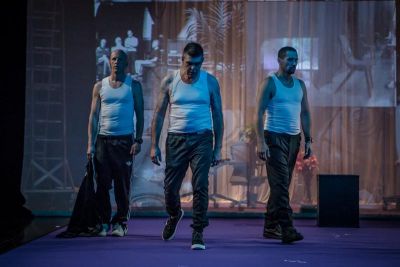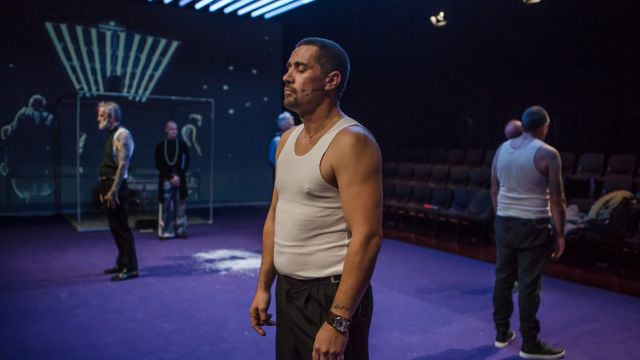The Chat
This is a show that questions the nature of ‘justice’ and the responsibility of a society (us never-been-arrested-never-been-charged folks) that leaves it up to the ‘justice system’ to administer it – not so well. There are eight performers – Nick Apostilidis, Arthur Bolkas, Ty Luke, Nick Maltzahn, John Tjepkema, J R Brennan, Ashley Dyer and David Woods. Some of them are ex-crims, big blokes who look like they’ve been around the block, but one wears a dog collar and is covered in tattoos, while another wears floral trousers and long string of pearls. There are big screens on which video can be projected – or behind which more action can happen; there are coloured lights and a box-like interview room with its own camera. There are also a lot of visual ideas; for instance, how a crim’s ‘record’ follows him and clings to him; how prison consists of authoritarian but useless drills and regimes; how some therapists with good intentions are out of their depth; and how prisoners themselves can beguile the unwary… The show’s creators acknowledge that the show is experimental – ‘The risk is fresh each night.’ A primary aim is to provoke discussion – and the audience is challenged to participate.
There are some tenuously linked elements that split our attention and blur focus – for example, a man on a throne, dressed in a ram’s costume, pronouncing on the action, some garbled dialogue in what may be a staff room, a man tricked into walking into a door and spending the rest of the show in a neck brace, and some free form dancing led by Ashley Dyer in the floral trousers. Mr Dyer is, I guess, the facilitator/therapist and he plays it as if he’s a newbie feeling his way; it’s ironic given that in ‘real life’ Mr Dyer is a facilitator, working with non-artists to make art. But we see the pressures on men in prison: not just enforced conformity and a pretence of obedience, but the role models – good and bad – that they carry in our heads: the priest, the tough guy, the successful criminal.
 But then the show fixes on its central set piece: a parole officer interviews a prisoner to ascertain whether the prisoner will gain parole. Here’s the switch. This is the crux of the ‘workshop’ nature of the piece: the process or transaction is called ‘transpersonalisation’. It means that the prisoner, Arthur (Mr Bolkas), plays the patrol officer and actor and co-creator of the show, Mr Woods, plays the ice-addicted criminal convicted of theft and drug charges. A ‘parole board’ made up of the rest of the cast, and including three pre-arranged volunteers from the audience, assesses Arthur’s sincerity and readiness for parole paradoxically by assessing his performance – as someone else. It’s a challenging concept. It’s doubly challenging because we have to distinguish between Arthur’s role-playing as the parole officer and Arthur as Arthur.
But then the show fixes on its central set piece: a parole officer interviews a prisoner to ascertain whether the prisoner will gain parole. Here’s the switch. This is the crux of the ‘workshop’ nature of the piece: the process or transaction is called ‘transpersonalisation’. It means that the prisoner, Arthur (Mr Bolkas), plays the patrol officer and actor and co-creator of the show, Mr Woods, plays the ice-addicted criminal convicted of theft and drug charges. A ‘parole board’ made up of the rest of the cast, and including three pre-arranged volunteers from the audience, assesses Arthur’s sincerity and readiness for parole paradoxically by assessing his performance – as someone else. It’s a challenging concept. It’s doubly challenging because we have to distinguish between Arthur’s role-playing as the parole officer and Arthur as Arthur.
Mr Woods is quick as a whip; if this is improvisation – or not - he’s brilliant. His uncooperative, nihilistic criminal, initially silent or mumbling, then turns on his ‘parole officer’, asking questions for which there are no answers – like, ‘What’s the point?’ He provides a searing test for Arthur, who soon sounds as if he’s out of his depth and falls back on things worth living for from his life. His life? Arthur’s or the ‘parole officer’s’? This is funny, sad and tense.
As this painful interview proceeds, one huge screen shows surveillance camera images (just a reminder of context) and the other images as from a police interview camera. Then Mr Woods breaks the spell. Well, what do we, the audience, think?
The Chair of the ‘parole board’ (this is role-playing, remember) is not impressed; he reminds us that ‘Arthur’ is a very good actor. He reminds us that Arthur had a serious drug habit and was a thief. This is the first reference to the crimes of any of these characters and why they went to gaol. Of course, the Arts House audience is all for leniency and benefit of the doubt. Via a roving mike, audience members make well-meaning (naïve) suggestions about Arthur’s future.

It’s like a game of ‘Why Don’t You…? Yes, but…’ Arthur demolishes each suggestion with a patient bitterness – and then challenges the audience himself with the key question and a curse on us all.
Behind the scenes of this very complex show, Jenny Hector is the lighting designer and Alex Davies provides system design and custom hardware. Additional system and sound design is by Nick Roux, together with J R Brennan, who also designs the set and creates the video art. Emily O’Brien is responsible for production and stage management. Yvette Turnbull is costumes assistant to Willoh S Welland. As for direction, with a show that can and apparently does change with each performance, I’d guess Mr Brennan and Mr Woods co-ordinate, manage and wrangle together or in turns.
The show’s concept has been devised by real parole officer and theatre maker J R Brennan. Since 2014 and together with Mr Dyer, he has been doing performance workshops for people convicted of crime. Out of that – and working with the marvellous chameleon David Woods – has come this show. If it sounds a bit ‘worthy’ and antiseptic, it isn’t: it is funny, satiric, moving and gripping. Not surprisingly the show’s main burden is about rehabilitation, offender support, parole – and crucially society’s responsibility. Important issues at any time, but particularly timely right now. If all its ideas and images don’t quite cohere and sometimes lurch from one image or bit of business to the next, that’s okay. Better a plethora of ideas on a powerful moral topic than one or two whims stretched tissue thin.
Michael Brindley
Subscribe to our E-Newsletter, buy our latest print edition or find a Performing Arts book at Book Nook.

